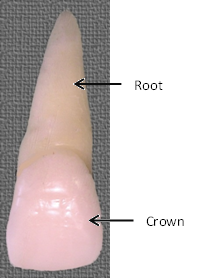If your child is experiencing pain or has had trauma to their teeth, please contact our practice for advice. If your child has a severe medical emergency (e.g. head trauma) or a swollen face from a severe infection or trauma, please seek medical attention.
Here are some tips on how to handle some dental emergencies. Traumatised teeth should be assessed as quickly as possible by a dentist to prevent pain and infection. In some cases, a traumatised tooth may need a root canal treatment or for the tooth to be removed.
Trauma to a baby tooth can affect the development of a permanent tooth, so it is important to have injured baby
teeth assessed.
What do you do if a permanent tooth gets knocked out?
• Find the tooth.
• Only hold the tooth by the crown (see picture.) Try not to touch the root at all – as the cells on this part of the tooth are very delicate and are needed for the tooth to re-attach itself to the mouth.
• If the tooth is dirty, you can quickly rinse the tooth (less than 10 seconds) – if necessary, but do not scrub the tooth or wash it with any detergents/soaps etc. Make sure to put the plug in the sink hole, if washing it in the sink.
• The best thing to do is to put the tooth back into the socket as soon as you can and bring your child to the dentist immediately. Try to place the tooth root first – into the socket and have your child bite a handkerchief or some gauze to hold it in place.
• If you cannot put it back into the socket, place the tooth in a cup with one of the following:
In order of preference: Viaspan™, Hank’s Balanced Salt Solution, or cold milk. If these are not available you could have your child spit into a cup and bring the tooth in the cup, covered in saliva. Tap water for tooth storage is not recommended, unless all other options are not available. Water can damage the cells on the root that are needed to re-attach the tooth.
• Bring your child to the dentist immediately. The longer the tooth is out of the mouth (measured in minutes), the less likely the tooth will be able to be saved. If the tooth is out of the mouth for over an hour it may not be possible to put it back into the socket of a growing child.
• Antibiotics will be required and Tetanus status will need to be assessed.
Sources: www.dentaltraumaguide.org and www.aapd.org






